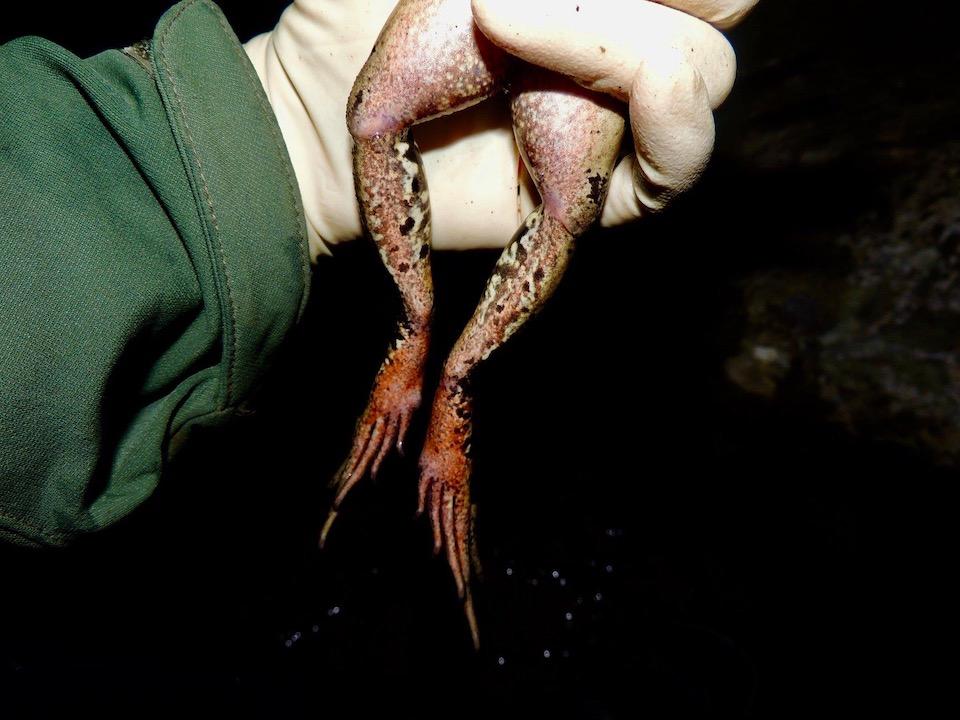
A California red-legged frog found during night survey/NPS
It appears that neither wildfires nor mudslides can wipe out populations of California red-legged frogs in the Santa Monica Mountains of California.
A recent survey by National Park Service biologists at Santa Monica Mountains National Recreation Area discovered 28 adult California red-legged frogs (Rana draytonii) in four translocation sites that were set up by Park Service biologists in 2014 in an effort to re-introduce the threatened species back into the Santa Monica Mountains.
During a number of night surveys that took place over the last few weeks, a handful of these amphibians were found in each of the four sites, a discovery that amazed Katy Delaney, a Park Service ecologist who has been leading the project since 2011.
The relocation project stemmed from the idea of using a source population of frogs found in the nearby Simi Hills that could help recover the species in the Santa Monica Mountains in four streams. Biologists hypothesized that they would eventually mature, mate, and reproduce on their own.
California red-legged frogs are listed as federally threatened under the Endangered Species Act and they are a state species of special concern. While the discovery of 28 adult frogs is positive, the future of the population in the Santa Monica Mountains is unclear.
“I still don’t know what’s going to happen, but it’s a big deal that these frogs survived the fire and the mudslides,” said Delaney. “I think that the fact that they survived all of that is extraordinary.”
Froglets, the stage in a frog’s life cycle that occurs after they are tadpoles, were found at two of the sites. Earlier this spring, tadpoles taken from the source population and reared at the Santa Barbara Zoo, were released in two of the streams.
Biologists surmise that older frogs were able to tough out a devastating wildfire and the subsequent mudslides that quickly followed.
“Maybe the little ones can’t survive,” said Delaney.
Another question biologists have regarding this sensitive species is if they will be able to breed on their own next spring.
To breed, frogs require deep breeding pools of year-round water and foliage, like willow. Female frogs lay their eggs underwater, but often near the surface. The egg masses are usually attached to willow roots or submerged sticks.
The important aquatic habitat and vegetation needed to successfully breed no longer exists in three of the four streams that were badly burned. To this day, almost one year later, these streams are still filled with silt, mud and debris.
Exactly one year ago, in the weeks prior to the fire, the rare amphibians were flourishing and reproducing on their own in two of the four streams spread throughout the mountains. There were a number of frogs living in each of the four streams - from tadpoles to grown adults. After the Woolsey Fire in November 2018 and the subsequent mudslides, biologists saw only two frogs - one at each of two sites.
In the other two reintroduction streams, the frogs were too young to breed in November 2018 when the Woolsey Fire swept through these sites. This year would have been the year for breeding with this specific grouping of frogs.
Partners in the reintroduction project are California State Parks, the Mountains Recreation and Conservation Authority, the Santa Barbara Zoo, the Santa Monica Bay Restoration Commission, the Santa Monica Mountains Conservancy, the U.S. Fish and Wildlife Service and the U.S. Geological Survey (USGS).



Add comment